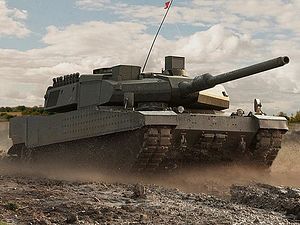Turkey’s first indigenously-designed, third generation+ main battle tank (MBT), designated Altay, is ready for serial production, the Hurriyet Daily reports. Hurriyet cites Turkish military vehicles manufacturer Otokar, a branch of the Koç Group, the country’s top industrial conglomerate.
The chairman of the board at Otokar, Ali Koç, told reporters in April that his company is “ready to fulfill all the obligations with the highest sensitivity and ambition in the Altay tank project, which is Turkey’s biggest land systems project.”
“We are ready for the job, with our human resource, from the subcontractor to our workers, experience, abilities and our passion to serve the best for our country,” added Koç.
As of now, no date has been officially set for the serial production of the tank to begin. There are still two other defense contractors competing for the contract to produce up to 1,000 tanks for the Turkish Army.
“We believe that the interest that the countries who are friends and allies have taken in the Altay tank will present a positive effect on defense industry exports in the long term,” Koç also said.
The head of Turkey’s defense procurement agency, the Undersecretariat for Defense Industries, Ismail Demir announced in January that Pakistan’s military is interested in procuring the Altay MBT, although there is no official confirmation from the Pakistani side that this is the case.
Reports that Pakistan is interested in the Altay have to take into account that Turkey’s new MBT will be an expensive acquisition for the Pakistan Army since the Altay is based on Western tank designs and will be a NATO-standard MBT.
Pakistan has traditionally relied on cheaper models such as the al-Khalid and al-Zarrar MBTs (both derivatives of Chinese-made MBTs) given that the Pakistan Army’s armor doctrine favors mass over class in order to partially offset the Indian Army’s numerical superiority.
It is thus unlikely that the Altay will become the new mainstay of Pakistan’s armor force. If acquired, it will likely be only to supplement a cheaper armored vehicle procured under the so-called “Haider” program.
The Altay is a formidable weapons platform as I explained in January (See: “Will Pakistan Buy Turkey’s New Advanced Main Battle Tank?”):
Otokar entered into a system development deal with South Korean tank maker, Hyundai Rotem, whose K2 Black Panther tank project serves as the basis for the development of the Altay. Both tanks share the same base design including the chassis, although the Altay is purportedly slightly longer, equipped with heavier armor, and, in comparison to the K2 MBT also sports a modified turret with composite armor.
Both tanks are also armed with a 120-millimeter smoothbore gun, although the K2 Black Panther MBT is equipped with an automatic loader, whereas the gun on the Altay has to be loaded manually. Furthermore, theAltay MBT has a laser guided missile firing capability and is additionally armed with 7.62 millimeter coaxial machine gun and a pintle-mounted 12.7 millimeter machine gun up top.
The Altay can accommodate a crew of four and with its German-made 1,500 horsepower engine can reach a maximum speed of up to 70 kilometers per hour (43 mph). In October 2015, Turkish engine maker TUMOSAN signed an agreement with the Austrian firm, AVL List, for technical support in designing an indigenous engine for for future batches of the Altay MBT.
Interestingly, Pakistan’s defense industry is also considering procuring the Altay’s third generation thermal imagining sight for the al-Khalid tank.

































